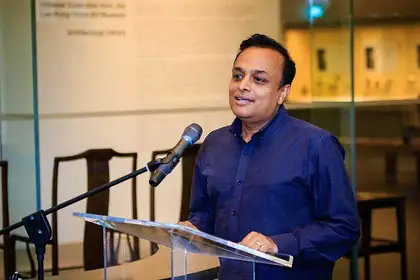
Professor Mohan Dutta.
By Professor Mohan Dutta.
The expression of white supremacy in the United States’ capitol on display earlier this month is not an exception. It exists in continuity with the everyday work of the machinery of white supremacy.
As a reflection of a larger infrastructure of white supremacy, it makes visible the forces at work every day in the US, and globally. This infrastructure seeds disinformation to propel a politics of hate. The insurrection in the US capitol is both a mirror into and a culmination of the ongoing work of powerful political and economic interests invested in keeping white supremacy alive and in perpetuating it in our societies to serve political agendas.
It is worth noting that the infrastructure of white supremacy has been held up by the political class, enabled by it, and reproduced by it. Donald Trump is not an exception, rather part of a larger network of politicians globally that draw on and profit from discourses of white supremacy. The appeal of Donald Trump and his “Make America Great Again” (MAGA) slogan globally reflects the affinities for white supremacy.
White supremacy is funded by the capitalist class, finding support in powerful economic forces. White supremacist messages have been and continue to be circulated in the mainstream media, with a number of these infrastructure owned by media mogul Rupert Murdoch. Digital communication infrastructures carry white supremacist messages. Powerful economic interests fund these digital infrastructures of white supremacy, all the way from the production of the messages to their circulation.
In summary, the project of white supremacy is fuelled by the political class and is sustained financially by powerful economic forces. In this backdrop, anti-racist interventions need to begin by critically interrogating the political economy of white supremacy.
Asking critical questions
Asking critical questions that closely examine the networks of hate is an important starting point to addressing the pervasive influence of white supremacy. Tracing the circuits of influence of white supremacy offers strategic registers for anti-racist interventions. Following are some examples of critical questions we ought to be asking:
(a) Who is funding white supremacy?
(b) Who is aligning with white supremacist arguments?
(c) Which politician is making white supremacist claims?
(d) What are the connections between these white supremacist claims and “Trumpian” white supremacy?
(e) Which politicians are voicing the interests of white supremacists?
(f) Which businesses are funding the campaigns of these politicians?
This complicity of the political class in protecting and perpetuating white supremacy is well evident in the attacks on both academics and activists that critically interrogate and expose the infrastructures of white supremacy. Consider for instance the sustained and ongoing attacks of politicians on critical race theory (CRT), a conceptual framework that critically interrogates the power dynamics that constitute the production and perpetuation of white supremacy in organisations, social formations, and communities.
The attack on CRT organised by the Trump-led White House is/was an expression of the white supremacist forces at work seeking to silence critical interrogations of white supremacy. The silencing of critical articulations that challenge white supremacy is vital to the project of white supremacy. Given legitimacy by Trump, the attack on CRT found legitimacy among white supremacist politicians globally.
Politicians often use the language of civility to carry out this attack on critics of white supremacy. Consider for instance the many instances where politicians have exerted their powers to contact university administrators, demanding a faculty member be fired for challenging white supremacists. These ongoing attacks on academics by white supremacist politicians have been seeded by white supremacist groups and circulated on white supremacist media.
The fact that politicians use the force of political power from opaque sites of influence to serve the agendas of white supremacy needs to be foregrounded in anti-racist conversations. Activists, academics, and the media have vital roles to play in making these linkages visible. Freedom of information requests should be used to track the number of times a politician has contacted a university to make demands that reflect the interests of white supremacist groups. Activists and academics must push universities to document, including maintaining paper trails of conversations, especially because these influences might be exerted with the purpose of making the influence invisible.
Simultaneously, the political structure and its corresponding security forces draw on the language of freedom of speech to enable white supremacist claims. In the case of the US, the security structures have been infiltrated by the ideology of white supremacy. Police, security structures, academia, and media leave white supremacist ideas unchallenged, with explicit references to freedom of speech.
White supremacists use the language of free speech to legitimise the rhetoric of hate. Any attempt at universities for instance to protect minority communities against the harm caused by white supremacy is targeted as repression of academic freedom. White supremacists directly fund, seed, or align behind organisations that proclaim to be the advocates for free speech to call for protections of white supremacist speech.
The language of taxpayer funding is deployed to build a moral panic, the purpose of which is to precisely safeguard white supremacy. This paradox, targeting speech critical of white supremacy as extremist and protecting white supremacist speech under the guise of freedom of speech, forms the strategic resource of white supremacy globally.
The US capitol riot makes visible the pernicious effect of white supremacy. It is important that we see these white supremacist flows and linkages beyond the US to study their effects globally. The work of anti-racist interrogations has to begin by questioning the complicity of our political class in perpetuating this infrastructure of hate.